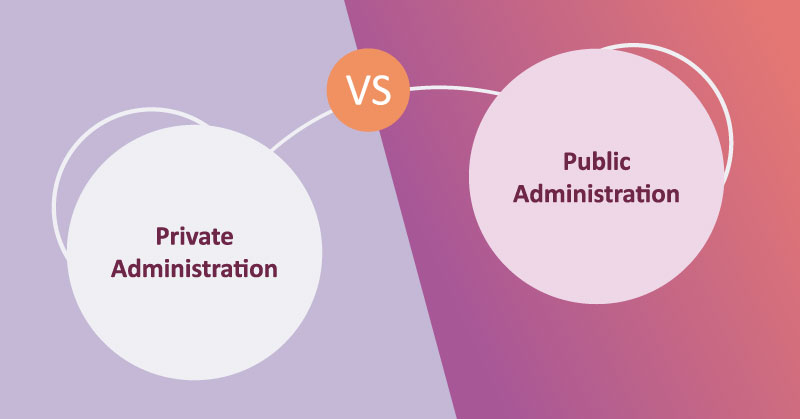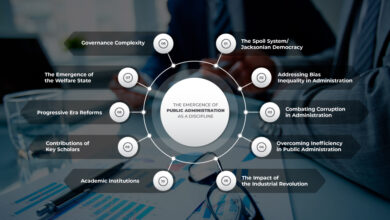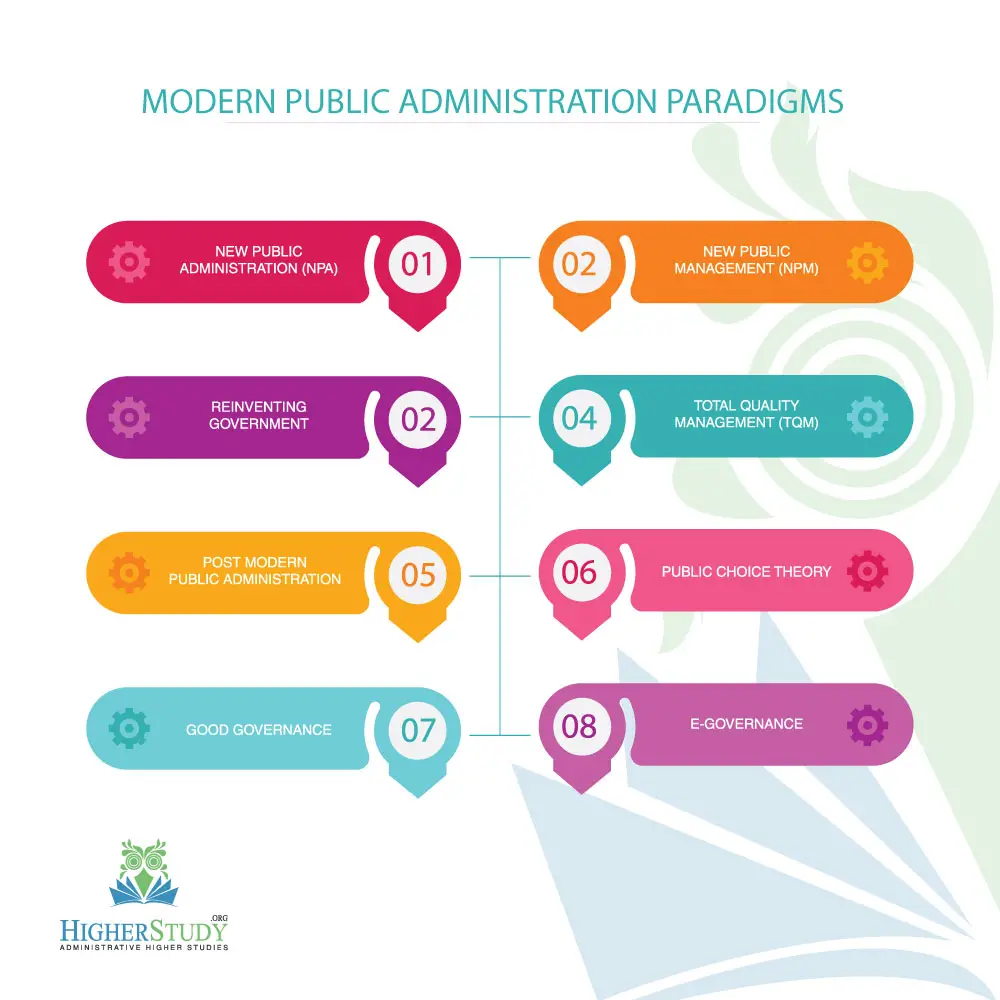Top 12 Difference between Private and Public Administration & Similarities
Exploring the Key Difference between Private and Public Administration: Objectives, Structures, and Impacts
The administration is the act of effectively managing the affairs of a business-related organization or state. It indicates the finest use of people, materials, and other properties of the organization to accomplish the company’s final goal. The administration can do it either by private individuals or public officials. Public administration is a branch of social science that works with service-oriented organizations. In contrast, private administration works with a business-oriented approach. However, the difference between private and public administration is described in detail below.
Table of Contents
Difference Between Private and Public Administration:
Understanding the difference between private and public administration is essential for grasping how these two sectors operate and contribute to society. Each plays a significant role in the governance and management of resources.
Moreover, when analyzing the difference between private and public administration, one can observe various factors that influence their operations, including political influences and accountability standards.
According to Paul Henson Appleby (he was an important American theorist of public administration in democracies), private administration differs from public administration in three important perspectives, as like
- Political character
- Impact and consideration on public accountability
- Breadth of scope
Josiah Stamp (First Baron Stamp) goes one step further and identifies four aspects of the difference. He brings up three more different issues, keeping Paul H. Appleby’s public responsibility or public accountability in check. These are-
- Principle of uniformity
- Principle of service motive
- Principle of external financial control
For instance, the difference between private and public administration can be highlighted in their accountability and operational motives.
In different explanations of Herbert Alexander Simon (he was an American political scientist), it has been found that the difference between private and public administration is coded in the viewpoint of the following things. Such as-
- Popular belief vs. Imagination
- Bureaucratic vs. Business
- Political vs. Apolitical
- Red tape vs. Free of it.
From Guru Peter Ferdinand Drucker (he was an Austrian-American management consultant, educator, and author), we can know that the difference has arisen in the following intentions. Such as:-
- Service intuition vs. Business intuition
- Differed purposes to serve, with different needs, values, and objectives
- Different kinds of contributions to society as well
- The way the performance and results are measured.
Additionally, it’s important to recognize the distinct objectives that define the difference between private and public administration in the context of service delivery.
Here is an article describes helps you understand the denotation and differences between private and public administration.
Link: Difference between Administration and Management

Definition of Private Administration:
Private Administration is the management and organization of private business enterprises. This is an administrative purpose carried out by private individuals, a team, or a group to profit. It is a business activity that is non-political in a landscape. It includes a collection of activities like planning, organizing, coordinating, implementing, and controlling programs and policies, performed by the organization’s management.
Private administration is such an administrative framework which is concerned the individuals, groups, enterprise, etc to generate a profit.
It works for the organization’s economic benefit, taking into account the concentration of employees and clients or partners, as well as the concerned organization.
Link: Difference between Participatory Management and Bureaucratic Management
Definition of Public Administration:
Public Administration in the field of study is concerned with the systematic application of public policies and programs formulated by the state. It relates to the administrative functions carried out by the government. It focuses on providing services to the general public to ensure a good and safe life for people. Read the What is Public Administration and Its Definitions article for more details.
Woodrow Wilson is the father of public administration. In 1887, he first formally recognized it through a well-known article. That article’s name is The Study of Administration.
PA is the art and the science of management as applied to the affair of state. Dwight Waldo
The public administration covers several principles. These principles are known as POSDCORB. Their principles are: –
- Budgeting
- Organizing
- Planning
- Controlling
- Staffing
- Directing
- Reporting etc.
In short, public administration is the non-political public bureaucracy that operates within a legal framework. It deals with the objectives of the government, public interest, and laws. All the government branches, i.e., legislative, judicial, and executive, as well as their relationship with each other, are covered in the public administration. It works on the principles of external financial control, uniformity, and service orientation.
Link: Difference between Development Administration and Traditional Public Administration
Difference Between Private and Public Administration Chart:
This table will provide the details about the Private Administration vs. Public Administration. Such as:-
| Comparisons | Private Administration | Public Administration |
|---|---|---|
| Meaning | Management, Organization, and Operation of a business enterprise. | Managing the resources of the government. Purpose achievement. |
| What is it? | Business activity | Political process |
| Approach | Egalitarian | Bureaucratic |
| Operation | In non-govt. set up | In govt. set up |
| Orientation | Profit | Welfare |
| Accountability | To owners | To citizens |
| Decision-Making | Monopolistic | Pluralistic |
| Revenue | Profits | Duties, taxes, fees, etc. |
Read more: Qualitative Research vs. Quantitative Research
12 Major Differences between Public Administration and Private Administration
There are pointed out some differences between public administration and private administration. Peter Ferdinand Drucker, Herbert Alexander Simon, and Paul Henson Appleby have made a clear distinction between public administration and private administration. They are-
1. Statement of Meaning
In government offices and institutions, all activities and management matters are termed public administration.
On the contrary, the activities of any privately owned company, private office, organization, NGO, and various non-governmental organizations are considered as private administration.
2. Perspective of Goal
The goal of public administration is to improve the effectiveness of justice, equality, public service, and efficiency, as well as to strengthen engagement with democratic values.
The main goal of the private authority is to fulfill the personal aspirations of different groups within a particular organization or organization. So it can only be said that it is a for-profit behavior.
3. Objective Viewpoint
The main objective of public administration is to implement the policy as well as to formulate correct and useful policy, which will be fruitful for the welfare of the people.
The main objective of the private administration is to implement all the interests owned by that individual and to formulate effective policies for their implementation.
4. Legal Framework
All the activities of public administration are regulated by a specific statutory law. There are limitations in various activities due to control. While this may seem like a bad thing at first glance, this regulation comes in handy for transparency.
No such law or regulation is observed in private institutions. By which the directors of private administration do not have to work through various limitations. Rather, they can amend and refine the law at any time as required.
Understanding the difference between private and public administration helps clarify their roles in resource management and service provision.
5. Public Accountability
Accountability of the administration to the public is the backbone of public administration. This is also called a major feature of good governance. An administrator is, directly and indirectly, responsible to the common citizen for all his faults and successes.
But such practice is not observed in private administration. They do not have to admit their guilt to anyone.
6. Matter of Discretion
In public administration, administrative discretion refers to the kind of actions that allow public administrators to have the flexible practice of approving and accepting judgments and making the right decisions at the right time.
The use of discretion in the private sector is almost the same. But the main difference between the two is the interest of the people and the interest of the owner, that is all.
7. Political Character
Public administration is ridden by specific regulations and political direction. The core task of public administration is to apply public policies.
On the opposite side, private administration is totally detached from politics. There is no political stimulus in the action of private administration. Its functions are focused on market forces.
8. Approach
In public administration, the bureaucratic approach is generally used to organize and manage operations. This involves a hierarchical system of authority in which people at different levels follow rules and procedures to make decisions. However, private administration typically features an egalitarian approach in which everyone has an equal say in making decisions. This may include employees, customers, or other stakeholders who have a vested interest in the company or organization. Private administration often relies more on personal relationships and trust than bureaucracy does, which can sometimes lead to dysfunction and chaos.
9. Income and Revenue
Public administrations generate their revenue from taxes, duties, and fees levied on citizens and businesses. Private administrations, in contrast, earn their income by selling products and services to the public. This can include everything from manufacturing and sales to health care and education.
10. Scope
Public administration is much wider than private administration. Compared to the limited services offered by private businesses, the citizens can get almost every essential service from public administration, like food, health facilities, education, communication, housing, transportation, and so on. These services are vital for a functional society and economy, and it is the responsibility of the government to make sure they are available to all citizens.
However, private administration deals with those sectors from which they earn profits. This generally includes providing goods and services that people are willing and able to pay for. Private businesses offer a variety of products and services, but there is usually a limit to what they can provide compared to what is offered through public administration. In addition, private entities may be more responsive to the needs of those who can afford to pay rather than all citizens.
11. Economic Interests
Public administration is usually independent of economic interests. As the goal of public welfare becomes the main one, in this case, financial gain or profit-making does not get special importance.
On the flip side, the efficiency and competence of the administration of a private organization are established by how the administration can increase the financial goals of the organization. In contrast, public organizations may be less competent because their employees are not predominantly motivated by financial improvement.
12. Freedom of Action
Freedom of action is a term used in public administration to describe the limited amount of freedom an individual has to act in a given situation. In private administration, such as in a business or household, people have much wider latitude to act as they see fit. This is because private administrators are not constrained by the same rigid rules and procedures that often govern public administrators. Private administrators can make decisions more quickly and efficiently since they are not weighed down by bureaucratic red tape.
Key Difference Between Private and Public Administration:
There are key differences between private and public administration. Such as: –
- The well-planned and systematic management of the state’s actions to accomplish the purposes established by the government, which is the Public Administration. The term private administration is the management, organization, and operation of a business enterprise’s actions.
- Private administration is a business activity. On the other hand, Public Administration is a political process.
- Private administration works in a structure other than the governmental setup, whereas Public administration works in a governmental setup.
- The private administration has an egalitarian approach. At the same time, Public administration follows a bureaucratic approach.
- Private administration uses monopolistic decision-making. But public administration is pluralistic.
- The revenue is produced from penalties, fees, taxes, duties, and other dues paid by the people in public administration, as opposed to private administration, where profits from operating activities are the main source of revenue.
- Public administration is welfare-oriented; it works with a service motive. Conversely, private administration is profit-oriented.
- When it comes to accountability, public officials are accountable to the general public, unlike private administration, where the employees are accountable to the owners.
Learn more: Difference between Cabinet and Cabinet Divisions/Council of Ministers
Similarities Between Public and Private Administration:
There are tried to explain the similarities between public and private administration through some important bullet points. Such as:-
- Both the business and government administration depend on planning, budget, delegation, organization, control, and other national strategies. Both use common skills such as account protection, file maintenance, etc.
- The policy of profit mods in modern times is not exclusive to the private administration. Profit-making is now acceptable as a good motive for the industry in the public sector. In addition, a private organization has also created a sense of community service. They understand that they have a broad responsibility in society.
- The practice of private organizations in personnel management has been greatly influenced by the practice of government organizations. In recent years, public organizations have also tried to install private business techniques and policies. For example, government corporations designed to conduct commercial operations and government-owned enterprises primarily model the concerns of private businesses. They are similar to the private organizations of nature.
- In modern times, private administration concerns are also legal barriers. The government is imposing a lot of control over business entities through tax, licensing policies, and surveillance as a result, they are not as independent as before.
Conclusion:
After discussing the difference between private and public administration, private administration is a business procedure, henceforward, careful as business administration. On the contrary, public administration runs in a governmental setting, which is why it is also known as government administration. Both of them play a crucial role in contributing to the development of society in different ways. Furthermore, the measurement of progress, results, and performance thereof can be done using different procedures.




Very good put up, I definitely love this website, keep on it